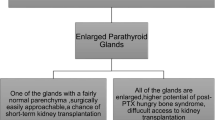Abstract
Since Slatopolsky reported that the intermittent high doses of calcitriol could suppress PTH secretion effectively in secondary hyperparathyroidism due to chronic renal failure, intravenous and oral calcitriol pulse therapy have enjoyed widespread acceptance. However, patients with far-advanced renal hyperparathyroidism are refractory to calcitriol pulse therapy and parathyroidectomy is required. Out of 157 cases who underwent parathyroidectomy for renal hyperparathyroidism between January 1991 and April 1994 at our department, 37 cases (23.6%) required parathyroidectomy because they were refractory to calcitriol pulse therapy. From evaluation of the preoperative and histopathological findings, we assessed the limitations of calcitriol pulse therapy. Our criteria as indications for parathyroidectomy in renal hyperparathyroidism include high PTH (C-PTH ≧20 ng/ml or M-PTH ≧50 ng/ml), the detection of swollen parathyroid glands by image diagnosis, high turnover bone or osteitis fibrosa findings on X-ray film and being refractory to medical treatment. In all but one case, the PTH level exceeded our citeria. In 4 cases, ectopic calcification, especially vascular calcification advanced and patients complained of ischemic symptoms. We emphasize that parathyroidectomy should be performed in patients with our criteria, before progression of vascular calcification and skeletal deformity. Some, 95% of these cases had more than one nodular hyperplastic glands. We estimated by previous pathophysiological examination that nodular hyperplasia was aggressively hyperplastic, with a high growth potential, abnormal PTH secretion and a diminished number of vitamin D receptors.
These clinical and pathophysiological results imply that when renal hyperparathyroidism is advanced, our criteria for parathyroidectomy indication are met, or when the parathyroid glands develop nodular hyperplasia, even calcitriol pulse therapy is not effective for hyperparathyroidism and so parathyroidectomy is required.
Similar content being viewed by others
References
Slatopolsky E, Lopez-Hilker S, Delmez J: The parathryoid-calcitriol axisi in healthy and chronic renal failure. Kidney Int 38, Supple. 29 S-41–S-47, 1990
Akizawa T, Fukagawa M, Koshikawa S et al.: Recent progress in management of secondary hyperparathyroidism of chronic renal failure. Current Opinion Nephrol Hypertens 2: 558–565, 1993
Tominaga Y, Tanaka Y, Sato K, et al.: Surgical treatment of secondary hyperparathyroidism. J Bone Miner Met 3: 294–300, 1991
Slatopolsky E, Weerts C, Thielan J et al.: Marked suppression of secondary hyperparathyroidism by intravenous administration of 1, 25-dihydroxycholecalciferol in uremic patients. J Clin Invest 74: 2136–2143, 1984
Tsukamoto Y, Nomura Y, Takahashi Y et al.: The oral 1, 25-dihydroxy vitamin D3 pulse therapy in hemodialysis patients with severe secondary hyperparathyroidism. Nephron 57: 23–28, 1991
Tominaga Y, Sato K, Numano M et al.: Indications for parathyroidectomy in renal hyperparathyroidism. Act Chirurg Austriaca 26 Suppl., 1994 (in press)
Jensen PS, Kinger AS: Early radiographic manifestations of secondary hyperparathyroidism associated with chronic renal disease. Radiology 125: 645–652, 1977
Takagi H, Tominaga Y, Uchida K et al.: Polymorphism of parathyroid glands in patients with chronic renal failure and secondary hyperparathyroidism. Endocrinol. Jpn 30: 463–468, 1983
Korkor AB: Reduced binding of3H 1, 25-dihydroxy vitamin D3 in the parathyroid glands of patients with renal failure. N Engl J Med 316: 1573–1577, 1987
Naveh-Many T, Marx R, Keshet E et al.: Regulation of 1, 25-dihydroxyvitamin D3 in the parathyroid in vivo. J Clin Invest 86: 1968–1975, 1990
Reichel H, Szato A, Uhl J et al.: Intermittent venous continuous administration of calcitriol: comparison of efficacy (Abstract). Nephrol Dial Transplant 7: 762, 1992
Delmez JA, Tindira C, Grooms P et al.: Parathyroid hormone suppression by intravenous 1, 25-dihydroxyvitamin D. A role for increased sensitivity to calcium. J Clin Invest 83: 1349–1355, 1989
Fukagawa M, Okazaki R, Tanaka K, et al.: Regression of parathyroid hyperplasia by calcitriol pulse therapy in patients on long-term dialysis. N Engl J Med 323: 421–422, 1990
Garrick R, Kumar U, Fallon M: The efficacy of intravenous (IV) and oral (PO) calcitriol (C) in the treatment of renal osteodystrophy. J Am Soc Nephrol 2: 610, 1991 (Abstract)
Takagi H, Tominaga Y, Uchida K et al.: Evaluation of image-diagnosing methods of enlarged parathyroid glands in chronic renal failure. World J Surg 10: 605–611, 1986
Tanaka Y, Seo H, Tominaga Y et al.: Factors related to the recurrent hyperfunction of autografts after total parathyroidectomy in patients with severe secondary hyperparathyroidism. Surg Today 23: 220–227, 1993
Tominaga Y, Tanaka Y, Sato K et al.: Supernumerary parathyroid glands in surgery for renal hyperparathyroidism. Act Chirurg Austriaca 26 Suppl., 1994 (in press)
Diethelm AG: The surgical treatment of secondary and tertiary hyperparathyroidism. Common problems in endocrine surgery. Year Book Medical Publisher, Chicago, pp. 173–182, 1989
Rothmund M: Surgical treatment of secondary hyperparathyroidism: Indication, operative management and result. Prog Surg 18: 186–205, 1986
Tominaga Y, Tanaka Y, Sato K et al.: Recurrent renal hyperparathyroidism and DNA a nalysis of autografted parathyroid tissue. World J Surg 16: 595–603, 1992
Wallfelt CH, Larsson R, Gylfe E et al.: Secretary disturbance in hyperplastic parathyroid nodules of uremic hyperparathyroidism: Implication for parathyroid autotransplantation. World J Surg 12: 431–438, 1988
Fukuda N, Tanaka H, Tominaga Y et al.: Decreased 1, 25-dihydroxyvitamin D3 receptor densityis associated with more severe form of parathyroid hyperplasia in chronic uremic patients. J Clin Invest 92: 1436–1443, 1993
Falchetti A, Bale AE, Amorosi A et al.: Progression of uremic hyperparathyroidism involves allelic loss on chromosome 11. J Clin Endocrinol Metab 76: 139–144, 1993
Author information
Authors and Affiliations
About this article
Cite this article
Tominaga, Y., Numano, M., Uchida, K. et al. Parathyroidectomy for patients with renal hyperparathyroidism refractory to calcitriol pulse therapy. J Bone Miner Metab 12 (Suppl 1), S99–S104 (1994). https://doi.org/10.1007/BF02375684
Issue Date:
DOI: https://doi.org/10.1007/BF02375684




